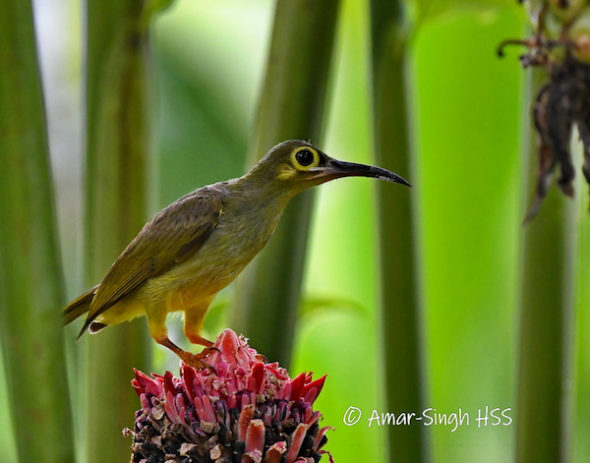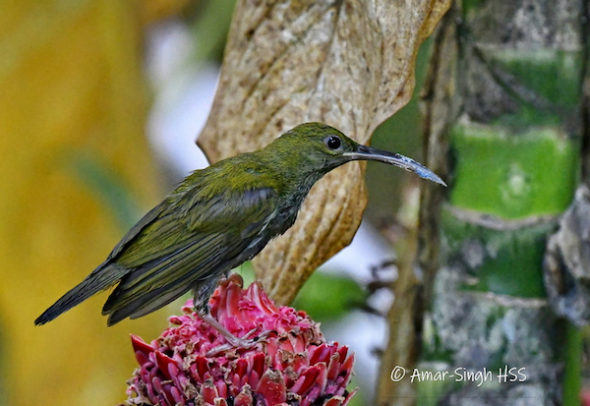The Etlingera elatior, commonly known as the Torch Ginger or Bunga Kantan, is an important plant in Southeast Asia and has spectacular flowers. The plant is cultivated for the flowers to be used as herbs, spices in dishes (rojak, laksa, kerabu) and as decorative cut-flowers. It is now widely grown in many countries.

The nectar requires a long-billed bird species and, as such, it suits Spiderhunters and Sunbirds. There is a lovely early discussion on this by Classen (1987) which describes the flower structure and bird bill/tongue required to reach the deep placed nectar.
Over time I have seen a number of birds that feed on the nectar of these flowers; as I am sure many other bird watchers would have observed as well. It is a favourite of Spiderhunters and Sunbirds and I have often observed competitive feeding at flowering sites of the Etlingera elatior. Yesterday (9th May 2022) I had an opportunity to observe 7-10 spiderhunters feeding on this plant at a location where it was flowering extensively, at the fringe of a forest reserve. Images show the Spectacled Spiderhunter and an immature Grey-breasted Spiderhunter.

Bird seen personally feeding on the nectar of the Etlingera elatior:
Little Spiderhunter Arachnothera longirostra
Spectacled Spiderhunter Arachnothera flavigaster
Grey-breasted Spiderhunter Arachnothera modesta
Brown-throated Sunbird Anthreptes malacensis
A limited online image and word search showed some other birds feeding on this flower (I have ignored here birds seen on the white variety of this flower).
Birds observed by other individuals feeding on the nectar of the Etlingera elatior:
Streaked Spiderhunter Arachnothera magna (see references in Amar-Singh HSS 2020)
Crimson Sunbird Aethopyga siparaja (Wee 2009)
Purple Sunbird Cinnyris asiaticus (Aswani et al 2013)
Purple-rumped Sunbird Leptocoma zeylonica (Aswani et al 2013)
Cameroon Sunbird Cyanomitra oritis (Janeček et al 2020)
Seychelles Sunbird Cinnyris dussumieri (CanStockPhoto)
Magnificent Sunbird Aethopyga magnifica (Ponds5)
Olive-backed Sunbird Cinnyris jugularis (Ponds5)
There are a number of images online showing different Hummingbird species feeding on this flower. Aswani et al. (2013) also mention the Greater Coucal Centropus sinensis as a nectar feeder on this plant but I would like more data on this.
I would not be surprised if many more Spiderhunter and Sunbird species feed on his plant, and further observation and reports are required.
References
- Regine Classen (1987). Morphological Adaptations for Bird Pollination in Nicolaia elatior. Gardens’ Bulletin Singapore 40(1). <https://www.nparks.gov.sg/sbg/research/publications/gardens-bulletin-singapore/-/media/sbg/gardens-bulletin/4-4-40-1-05-y1987-v40p1-gbs-pg-37.pdf>.
- Amar-Singh HSS. (2020). Diet and Foraging Behaviour of the Streaked Spiderhunter (Arachnothera magna). BirdingASIA 34: 114–120.
- Wee YC (2009). A male Crimson Sunbird and the torch ginger flowers. Bird Ecology Study Group. <https://besgroup.org/2009/01/09/a-male-crimson-sunbird-and-the-torch-ginger-flowers/>.
- Aswani K., M. Sabu and K. P. Smisha (2013). Reproductive Biology of Etlingera elatior(Jack.) R. M. Sm. Ornamental Torch Ginger. International Journal of Plant, Animal and Environmental Sciences.
- Janeček, Chmel, Gómez, et al (2020). Ecological fitting is a sufficient driver of tight interactions between sunbirds and ornithophilous plants. Ecology and Evolution. Wiley Online Library. <https://onlinelibrary.wiley.com/doi/full/10.1002/ece3.5942>.
- CanStockPhoto – Seychelles Sunbird <https://www.canstockphoto.com/a-seychelles-sunbird-cinnyris-58050349.html>.
- Ponds5 – Magnificent Sunbird <https://www.pond5.com/stock-footage/item/158515350-magnificent-sunbird-feeding-torch-ginger-plant-cebu-philippi>.
- Ponds5 – Olive-backed Sunbird <https://www.pond5.com/stock-footage/item/158514599-olive-backed-sunbird-cinnyris-jugularis-cebu-philippines>.
Dato’ Dr Amar-Singh HSS – Ipoh, Perak, Malaysia








